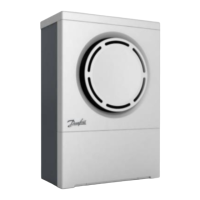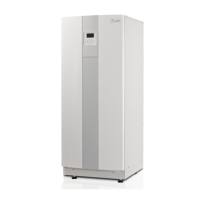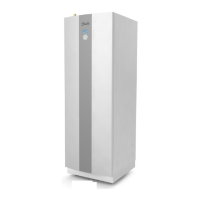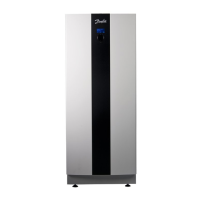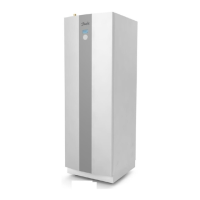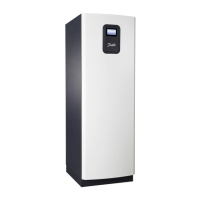Cause Troubleshooting Remedy
5. The compressor has been stopped
by the operating pressure switch or
delivery line sensor.
Check if a square appears in the display’s
lower left corner. If so, the operating pres-
sure switch is open or the delivery pipe
sensor triggers an alarm for too high tem-
perature.
•
The operating pressure switch is
most easily checked by using a buz-
zer to see if it is connected.
•
The pressure pipe sensor value is
read off from the control system in
the HEAT PUMP menu. Is it a plausi-
ble/actual value? If not, take a resist-
ance reading from the sensor and
check against the ohm table in Mät-
punkter.
•
The compressor has been stopped by
the delivery line sensor and you have
established that it shows the correct
temperature. This may have been
caused by a leak in the refrigerant cir-
cuit.
If the operating pressure switch has
stuck in the open position, try gently
tapping on the pressure switch head. If
this does not help, or it sticks in the
open position repeatedly, replace the
pressure switch. If the delivery line sen-
sor is defective, replace it. If the delivery
line temperature gets so hot that the
compressor stops, start by leak-tracing
the unit. Rectify the leak, if a leak is
found. If no leak is found, try draining
and refilling the unit and then restarting
the heat pump and seeing what the
delivery line temperature is. If the prob-
lem persists, replace the compressor.
6. The built-in overheating protection
(bi-metal protection) in the compres-
sor has tripped.
Check if the heat pump’s control com-
puter indicates that the compressor is in
operation, and if there is voltage in the
soft-starter control inputs. Then read off
and check that there is voltage on the
compressor’s electrical connection(s).
If there is voltage on the compressor’s
electrical connection(s) and the over-
heating protection does not close when
the compressor has not run and has
cooled down for at least 1 hour, replace
the compressor.
7. The compressor runs backwards. The
incoming phases have the incorrect
sequence (only applies to 3-phase heat
pumps). If the compressor runs back-
wards, it will not cope with compress-
ing the refrigerant and therefore does
not produce the correct power, which
leads to the control system requesting
auxiliary heating.
•
If the text ERR PHASE SEQ. appears in
the display when the heat pump is
powered, (only appears in the first 10
minutes) this means that the phases
have the incorrect sequence.
•
When the compressor is running,
check the pressure pipe temperature
by feeling the pressure pipe. If the
phases are correctly sequenced it
should be hot (not just warm) even a
distance from the compressor.
•
When the compressor runs with the
phases incorrectly sequenced a
strange noise may be heard (loud,
rattling) when the compressor runs
backwards.
If the phases are in the incorrect order,
switch two incoming phases at the main
terminal block and recheck according to
the troubleshooting window.
Table 36. Problem – The heat pump consumes too much energy
Cause Troubleshooting Remedy
1. Blocked strainer in the heating sys-
tem.
Check that the strainer is not blocked. Clean the strainer if necessary.
2. The compressor cannot run due to
an alarm.
Check the alarm that is indicated in the dis-
play.
Rectify the problem and rest the alarm.
See the Operational problem – Alarm.
3. Incorrect flow over hot side of the
heat pump.
Measurement check what the difference
between the supply and return line is using
a thermometer (∆t). The difference should
be about 7-10°C (can vary depending on
refrigerant). A lower ∆t results in reduced
efficiency in the heat pump.
Adjust the system to obtain the correct
∆t.
4. Incorrect flow in the brine circuit. Measurement check what the difference
between the supply and return line is using
a thermometer (∆t). The difference should
not be more than 4°C. A greater ∆t results
in reduced efficiency in the heat pump.
If the difference is greater than 4°C note
what is causing it. E.G.: Dirt in the filter,
system restrictions, system with high
pressure drop.
56 – Service instructions VMGFC302
